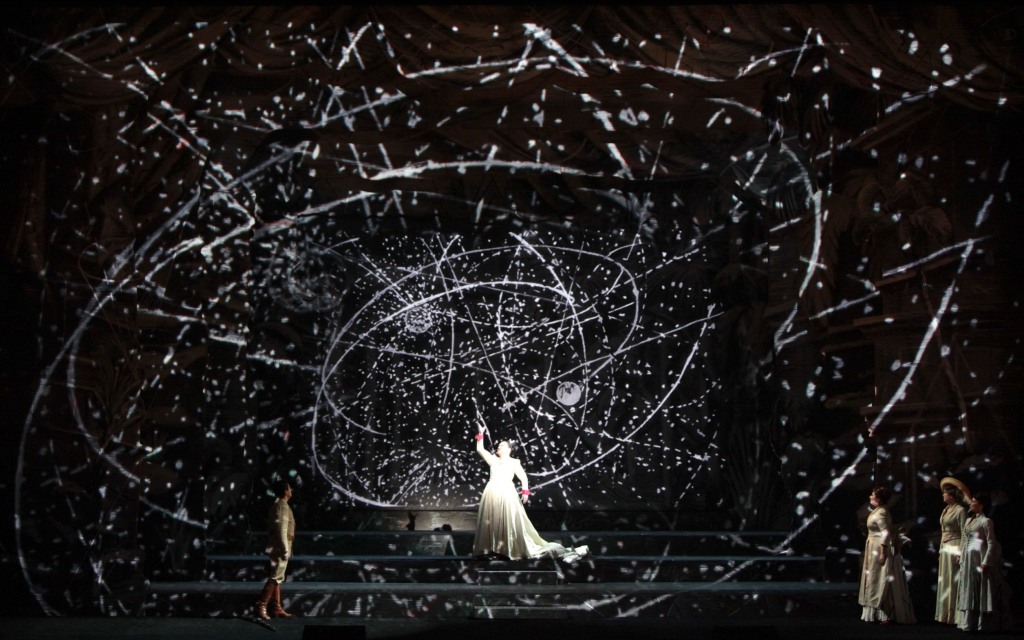
常有讀者問我,某個演出「值不值得看」,例如昨天就有人問我推不推2022年底臺中歌劇院的《魔笛》。事實上他發問的24小時前,我已經聽完二卡歌手錄音、看了這個製作的錄影、也看了些關於製作的相關評錄,做完決定。看表演前做功課很重要,因為花錢事不小,花時間看不喜歡的表演更痛苦。不過參考別人的意見時,要注意每個人的口味和考慮基礎不同。以我而言,我覺得《魔笛》很無聊;所以除非台中借來的製作、或者延請的音樂陣容很吸引人,否則我實在不想跑去坐二、三個小時,還不提交通與住宿。(不過下面我還是會談談這次做功課的結果。)
事實上,澳洲導演Barrie Kosky也覺得《魔笛》很無聊;後來他任職柏林喜歌劇院時,就和英國「1927 」劇團合做了個熱鬧的製作,大幅運用Paul Barritt的動畫,也就是2019年衛武營借的那個製作。我當初去看,幾乎完全是為了製作本身,加上我沒有現場看過完整製作的《魔笛》。當時A、B卡歌手(純粹以演出先後分,沒有明顯好壞)中,唯一很想聽的是B卡的Pamina公主,雖然A卡的Papageno和夜后應該比較好。所以最後我看了一場Pamina很優秀、其他歌手不怎樣、製作熱鬧但讓音樂綁手綁腳而且視覺上後面有點令人疲乏的《魔笛》(評論看這裡)。
回到2022台中《魔笛》。這個製作大部分評價不錯,我後面選錄了二則,但看了其中的敘述,並不是我喜歡的類型。網路上有長達2小時42分鐘的完整錄影,我看了超過90分鐘(一路看到夜后第二首詠嘆調結束後),覺得這個製作的導演有置入自己想要的意念,但不完整,而且除此之外,是個非常傳統的製作。說難聽是歌手沒有得到什麼演技上的指引或奧援—這點我很介意;說好聽是觀眾可以專心在歌手表現上,但這意味著音樂水準真的要很強。
說到這點,我討厭《魔笛》的原因之一是,雖然音樂似乎通俗非凡(全世界至少都認得出夜后第二首詠嘆調轉大調的部分),但音樂很難演好,口白編修也是問題,略長時不只可能拖戲、還有口音問題。劇情更讓人頭疼:雖然由於從小熱愛歌劇,所以歌劇和戲曲只要有部分段落能呈現戲劇說服力,我就會買單,但《魔笛》戲劇零碎混亂,極難讓人認同。《魔笛》最能讓我感動的,是Pamina在以為Tamino不再愛她時,悲傷唱出的 “Ach, ich fühl’s, es ist verschwunden"、以及她想自殺時三名仙童與她的互動。問題是,這位姐姐戀愛的基礎完全是「聽說對方愛她」而已耶!偏偏全劇和她互動最多的明明是Papageno。相較於看了美女圖後就把自己捐進去、還乖乖服從不合理指令的Tamino(有沒有感覺到網路交友詐騙的節奏?),Papageno乍看是唯一比較「正常」的討喜角色,但先等等:他的夢想是把全天下女生關在他家、部分賣掉部分、自己使用;討不到老婆時一哭二鬧三上吊,討到老婆時老婆的功能是幫他一個接一個生小孩?…..
結果全劇最像常人情感的,是三位侍女見到帥哥時的爭風吃醋。可惜她們後來完全沒有戲劇發展。
那麼這次的陣容呢?如果以0~5來表示「想聽」的程度,那麼本次台中A、B卡分數如下(想聽的程度噢,不是預期表演的好壞、或實際上的好壞):
Dec. 15th & 17th
- Tamino / Terrence Chin-Loy 2.5 :聲音有點特色,技巧和風格都有明顯破綻,應該是亞利桑那駐院歌手
- Papageno / 尚未公佈人選
- Queen of the Night / Yasui Yoko 3:穩定在東京新國家劇院演出
Dec. 16th & 18th
- Tamino / Konu KIM 3:有好的抒情特質,法文又有破綻,德文不知道。已經拿到諸如柯芬園等較佳劇院主角。
- Pamina / Tamara Banješević 4.5:聲音特色和音樂性似乎值得聽。之前唱女人皆如此詠嘆調技巧還有破綻,不知是否解決。
- Papageno / 趙方豪 CHAO Fang-hao 3.75:顧好抒情圓滑線條、不要衝的話,應該不錯。
- Queen of the Night / Viktorija Đurđek 3.5:有優點,不過高音可能較浮。
當然,上述是聽網路影片做的粗淺判斷,過往績效不代表未來績效,何況這些主要是年輕歌手。以我自己而言,如果人剛好在台中又有閒錢,那可能會想去看B卡演出。至於一般不討厭/會想看的《魔笛》的觀眾,只要不介意製作本身對戲劇幫助不大(干擾也不算大就是),當然也可以挑自己喜歡的卡司去看。
延伸閱讀:2022年高雄春天藝術節《蝴蝶夫人》演出前對男高音的評估。
📢支持創作,請緊緻圓滑奏喝咖啡吧!
關於製作,你可以自己看以下的全劇錄影。
以下我也節錄二則英文評論—如果有刪節,都是關於演出者本身的部分,而且有加中引號。
(一) 2012/5 Gramophone的Richard Lawrence評論Opus Arte版DVD
Kentridge’s La Monnaie Magic Flute filmed at La Scala
William Kentridge’s production of Die Zauberflöte was first seen at La Monnaie in Brussels in 2005. Since then it has been staged in a number of theatres – including one in Kentridge’s native South Africa – before reaching La Scala last year. It is very much ‘producer’s opera’ and it will annoy some people. I found it fascinating, despite having reservations on both fronts, musical and philosophical.
Although Kentridge is dismissive of Freemasonry, he does see the opera – how could he not? – as a conflict between light and darkness. But in an interview he describes his production as ‘a kind of a distant polemic against Sarastro and against the notion of the pure light of reason’, adding that ‘reason comes not from pure clarity but from somehow muddling in the space between darkness and light’. He takes as his metaphor the cinema, where ‘blinding light means there is no more film in the projector’; and there is a box camera on the stage, through which the characters peer from time to time.
The metaphor becomes reality in Kentridge’s brilliant use of video projections, including the serpent pursuing Tamino, the three temples, and various geometrical symbols. These are animated drawings; but during Sarastro’s ‘O Isis und Osiris’ there is old film of what looks like a couple of Boers with rifles. What’s all that about? Well, during ‘In diesen heil’gen Hallen’ those huntsmen are seen shooting a rhinoceros, as Pamina looks on in horror; and when in the Act 1 Finale Tamino played his flute, it was a cartoon rhino that was shown cavorting. Innocent nature versus wicked mankind, I suppose, and a heavy-handed example of Kentridge’s anti-Sarastro polemic. For the Queen of the Night he recreates the well-known starry sky that Karl Friedrich Schinkel designed for Berlin in 1815.
The video projections are in black and white but there’s plenty of colour in the costumes: a safari suit for Tamino, a brown frock coat for Papageno, Pamina in a red dress, Sarastro and his entourage – especially the Speaker – in natty floral waistcoats. Monostatos is a late-19th-century Ottoman, complete with fez and waxed moustache.
I almost forgot the singers. Excellent Queen and Pamina; the men less so, except for Papageno. Lively musical direction, incorporating René Jacobs’s superfluous keyboard interjections. Don’t miss this visually enchanting and thought-provoking treat.
(二) 2007/4 New York Times的Bernard Holland評論
The Flute Is Awfully Nice, Tamino, but Check Out That Astral Sketchbook
William Kentridge, who conceived and directed the visiting production of “The Magic Flute” at the Brooklyn Academy of Music on Monday night, is a black-and-white man. His flat scenery is not so much painted as rubbed and scratched by charcoal on white paper. Not surprisingly Mr. Kentridge is interested, if not obsessed, by early motion pictures and their first attempts at animation.
From flickering screens onstage birds fly in little hiccups of movement. An animated rhino does endearing back flips. Cut-out suns and moons are beamed with calculated awkwardness across the stage. These faux-primitive re-enactments of early film are one side of Mr. Kentridge’s exploration of this Mozart opera. Another is his determination to illustrate the power of the Enlightenment at the end of the 18th century and how it captured this magic-theater blend of the mystical and the down-to-earth for its own.
To this end Mr. Kentridge “draws” on the stage, with electric light used as a draftsman’s pen to create elegant graffiti. Examples of solid geometry are diagramed. Doodles move in graceful arcs. Architectural drawings and their specifications appear like wallpaper. Images of palace interiors and waterside exteriors serve as moving scenery. The Queen of the Night is backlighted by a skyful of starry dots.
In front of all this an opera is going on, and when it starts in earnest, one tends to forget about Mr. Kentridge altogether. Given his very different visual imagination, this South African artist-director has come up with a “Magic Flute” of otherwise perplexing conservatism, with hardly a touch to separate it from a hundred other “Magic Flutes” put on in the last 200 years.
And why not, given the quality of the music and the quality of this cast from La Monnaie, the Royal Opera House of Belgium? Let Mozart speak, one can argue. And yet, why, all evening, the nagging feeling of disconnect between original image and boilerplate direction, the sense of distance between singers “in living color,” and backgrounds of light and shadow only — all giving the impression of parallel but distinct worlds. At moments the worlds merged, with players enveloped in light or threatened by swooping showers of sparkle. These moments deeply satisfied.[…]
As this “Magic Flute” worked hard to remind us, the Enlightenment truly believed it could herd the loose ends of humanity into a manageable space, capture the impulsiveness of a Tamino or the unruliness of a Papageno, and comfort both in a place designed by scientists and soothed by art. After Mozart’s last note is played and the curtain falls, one feels the ambiguity of such a paradise. Pamina and Tamino face each other and dissolve into colorless silhouettes, frozen against the black-and-white world this director loves so much.
